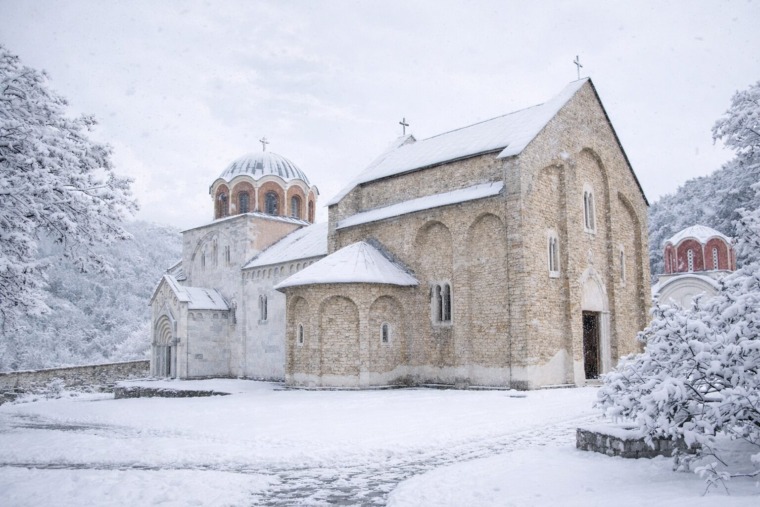

While the majority of world marks December 31st as a start of a New Year and the end of holiday madness, people in Serbia mark this date as the very beginning of the same. In Serbian households all around the country and the world, that is the time when people start preparing for the happiest Christian holiday- Christmas, but also for the other, Orthodox or Serbian New Year.
If you end up in Serbia in the middle of January, don’t be surprised to see a holiday euphoria which is still going on here. Decorated trees and streets, crowd at the stores and markets are just a part of preparations for celebration of another New Year. Yes, you’ve heard it right. Holidays in our country end after the 14th of January. And why is that? There are several reasons and explanations.
 The first and main reason sends us back into the long gone 1582 when Pope Gregory XIII announced the reform of the existing Julian calendar. Namely, because of the difference between Julian and natural year which has eventually got to the point of 40 days difference, the Pope decided to ban it and introduce Gregorian calendar. That way, the difference compared to the natural, solar year was reduced.
The first and main reason sends us back into the long gone 1582 when Pope Gregory XIII announced the reform of the existing Julian calendar. Namely, because of the difference between Julian and natural year which has eventually got to the point of 40 days difference, the Pope decided to ban it and introduce Gregorian calendar. That way, the difference compared to the natural, solar year was reduced.
Until the 20th century, Julian calendar was replaced by the new version of Gregorian one in the majority of countries, but many national Orthodox churches still wanted to use it. Serbian Orthodox Church as well. That is how Serbs are one of rare nations whose church continued using the old calendar as the official one, and in accordance with this, they celebrate New Year on the 14th of January. That date marks the January 1st according to the Julian calendar.
The tradition of marking the New Year according to Julian calendar is respected in Russia, Belarus, Ukraine, Armenia, Moldova, Georgia and the Balkan countries such as Montenegro, Bosnia and Herzegovina and Macedonia. This custom also exists in some German cantons, Switzerland and Scotland.
Another reason why Serbs haven’t given up on celebrating Serbian New Year, lays in the spite according to the many. Namely, in 1919, with the foundation of Kingdom of Serbs, Croats and Slovenes, January 1st is established as the first day of New Year, and marking Serbian New Year was considered inappropriate. That is when the new Gregorian calendar was adopted for the non-church purposes.
Everything was like that until 1923, when Serbian New Year was celebrated publically and defiantly, although it wasn’t a National holiday. The famous Belgrade kafana “Kasina” was the first one to throw a celebration of Orthodox New Year, and other kafanas, cinemas, military homes, etc. have been joining the celebration over the years.
The approach of communism caused another banning of Serbian New Year. Kafanas had to be closed until 10 pm, New Year’s presents were backed up from stores during religious holidays, and public gatherings on streets were also banned. Stories from that time tell that Serbs continued to celebrate this holiday in strict confidentiality.
At the beginning of the 90’s, celebration of Serbian New Year started gaining its today’s form. Nobody was hiding anymore, housewives were baking the cakes with pleasure again, a pig was turning on a spit, kafanas were full and celebrations were organized at the city squares, as well.
One of the most unusual and at the same time the largest street celebrations of Serbian New Year, happened in 1997 when thousands of people on the Republic Square and the streets across Belgrade celebrated and at the same time protested against politics regime of that time.
Today, many families around Serbia celebrate the old or Serbian New Year, but it also celebrated by the Serbian families abroad. Some of them stay in their homes, some go to kafanas, clubs and restaurants, but there are also those who end up in front of the Church of St. Sava or at some city square. No matter where they are or how they are going to spend it, Serbs have never given up on celebration of this Orthodox holiday.
Featured photo: www.srbijadanas.com
Related Articles


From Fireworks to Family Dinners: New Year’s Eve Across Serbia
December 31, 2025
Kuršumlijska Banja: Serbia’s Quiet Winter Spa Escape
December 30, 2025






